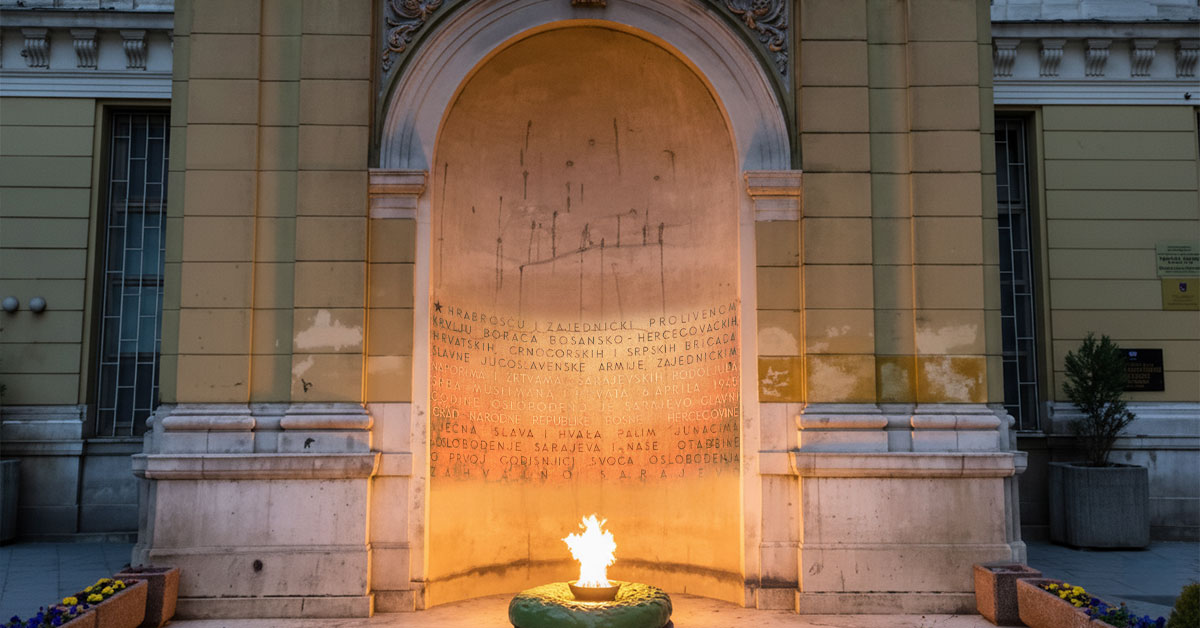At the junction of Ferhadija and Maršala Tita, in the thick of the city’s foot traffic, a small flame does important work: it reminds passers-by why 6 April in Sarajevo always feels like a fresh breath. Eternal Flame Sarajevo (Vječna vatra) is dedicated to the military and civilian victims of World War II and to the city’s liberation on 6 April 1945. It was inaugurated on 6 April 1946 in a shallow niche of a former bank palace—so remembrance isn’t separated from daily life, it lives in it. The author is architect Juraj Neidhardt, who shows here how measure and closeness often beat mass and pathos.
Table of Contents
Where is the Eternal Flame Sarajevo and how to recognize it?
Walking west along Ferhadija, a yellow plaster façade reveals a semicircular niche. At its center: a low, bronze-green ring with the flame. Behind it, on the stone wall, a long dedication that names and thanks. Eternal Flame Sarajevo is literally “on the corner”-where Ferhadija, Maršala Tita, and Mula Mustafe Bašeskije meet-so it’s almost impossible to pass through the center and miss it. In the crowd you’ll spot it by the instinctive slowing of people: in front of the flame, a half-step of silence happens naturally.
Why 6 April: what Eternal Flame Sarajevo commemorates
After four years of occupation, Sarajevo was liberated on 6 April 1945. Exactly a year later, on the same date, the Eternal Flame was lit. Since then, 6 April is Sarajevo City Day: delegations, veterans, schoolchildren, and passers-by lay flowers here every year. Over time the memorial has also become a bridge to newer memories-citizens sometimes leave a flower for the victims of the 1992–1996 siege, so the flame symbolically connects epochs.
Author and form: how Juraj Neidhardt “measured” Eternal Flame Sarajevo
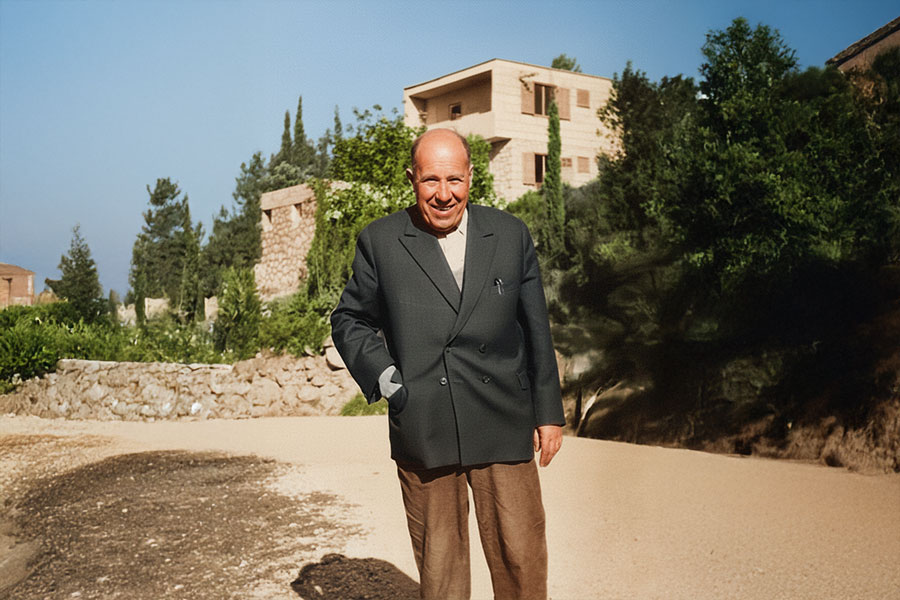
Neidhardt’s solution is a lesson in modest monumentality. Instead of a tall obelisk—a low niche in a living urban space. Instead of statues—a ring and a flame at eye level. Instead of barriers—open access: you approach Eternal Flame Sarajevo like a shop window, without ceremony. Materials are archetypal and durable (stone, metal, fire), and the whole composition is woven into the street’s rhythm so it “works” every day: people come, read, pause for a minute, and move on—richer for a thought they didn’t have to seek out.
The inscription behind the flame: how to read Eternal Flame Sarajevo’s message
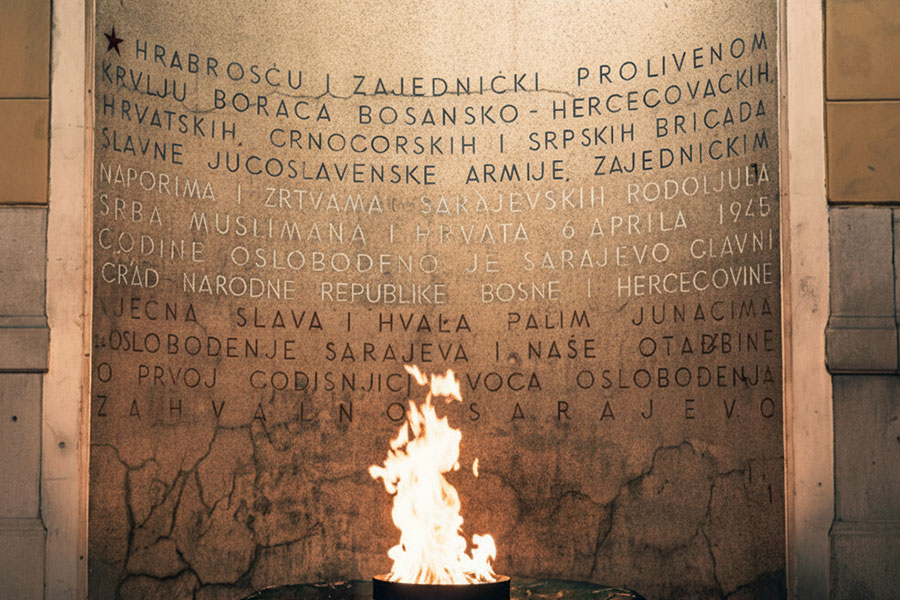
The wall text is a concise map of gratitude: it speaks of blood shed together and the joint effort of different units and citizens of different faiths and nations that led to 6 April 1945. It’s not mere protocol; it explains the method of victory: together. If you’re here for the first time, take a minute to scan the inscription from top to bottom-this is the shortest possible history lesson etched into the façade of Eternal Flame Sarajevo.
Continuity of the flame: when Eternal Flame Sarajevo went out-and burned again
Since 1946 the flame has burned continuously, except during the siege of Sarajevo, when it was extinguished at times due to a lack of gas. After the war it was relit and returned to daily city life. There have been isolated vandalism incidents or technical interruptions, but the response is always the same: swift repairs and the flame’s return. The message is clear—remembrance is maintained like the flame itself: with care, repetition, and proximity.
How to visit Eternal Flame Sarajevo respectfully
The memorial is outdoors and accessible at all times. There are no gates or tickets, but there is etiquette: approach calmly; don’t step over the ring; take photos discreetly without blocking the way; if you find a commemoration or fresh flowers, pause for a minute in silence. The nicest angle is oblique to the niche, so both flame and inscription are in frame—only then does the photo tell the full story of Eternal Flame Sarajevo.
Getting there: practical tips for reaching Eternal Flame Sarajevo
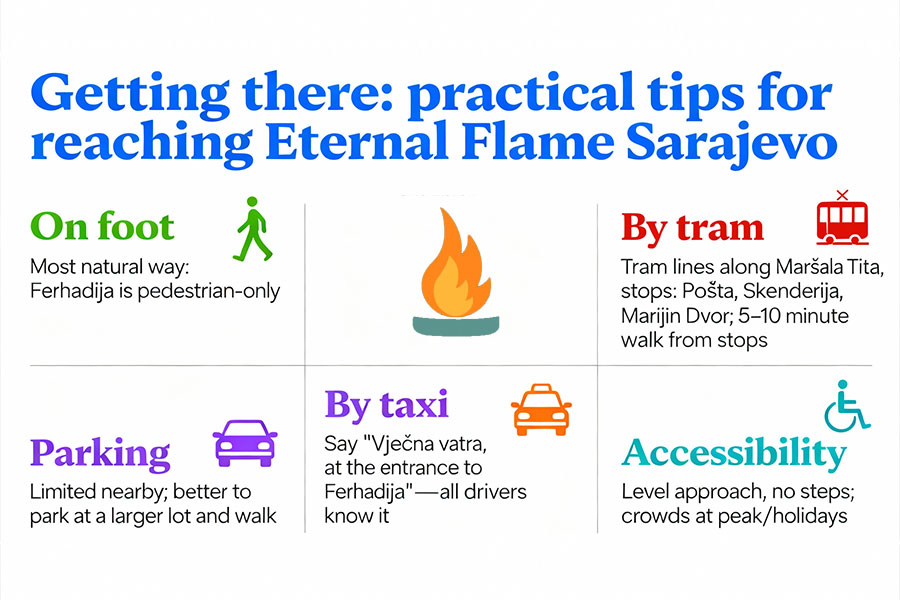
The most natural way is on foot, since Ferhadija is pedestrian-only. Tram lines along Maršala Tita have several stops (e.g., Pošta, Skenderija, Marijin Dvor) from which it’s a 5–10 minute walk. In a taxi, say “Vječna vatra, at the entrance to Ferhadija”—every driver knows it. Parking nearby is limited, so it’s better to leave the car at a larger lot and walk. Accessibility is good: the approach is level, with no steps; the only real obstacle is crowds at peak and on holidays.
Best times to photograph Eternal Flame Sarajevo
Daytime preserves color and contrast on the façade, making the inscription more legible; golden hour gives a warm halo to the flame and softens the letters’ shadows. At night the city calms and the flame takes over “direction.” For a wide shot, step back about ten meters along Ferhadija and let the context “enter” the frame; for a detail, move closer to the niche and focus on flame + text. Rain and snow often yield the most poetic frames—reflections on the pavement literally “rewrite” the text with light.
What’s near Eternal Flame Sarajevo: a 60–90 minute walk
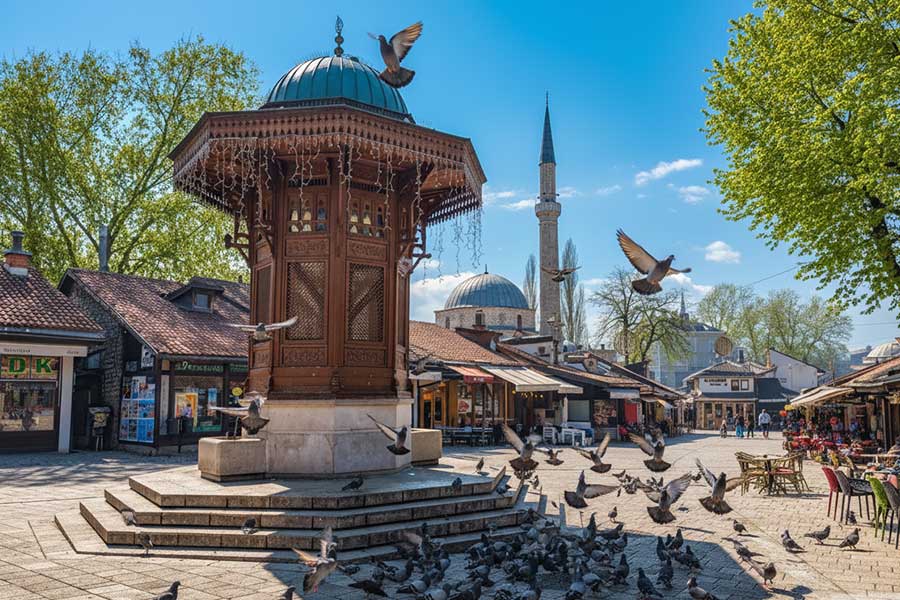
From Eternal Flame Sarajevo, head east along Titova to the Cathedral, then enter Ferhadija and continue to Baščaršija and Sebilj. A couple of streets away you’ll find galleries, bookstores, and the Old Synagogue (Jewish Museum); in the other direction (west) are the BBI Center and Trg djece Sarajeva. If you have another half hour, continue to the Latin Bridge and City Hall—a lovely line that connects several eras in one stroll.
A network of memory: how Eternal Flame Sarajevo “speaks” to other memorials
Eternal Flame Sarajevo is a starting point for a small network of memorials: within minutes on foot are the Markale sites, the memorial to the children killed during the siege, and plaques and markers along Zmaja od Bosne (the former “Sniper Alley”). There’s no need to see everything at once; it’s enough to know that remembrance in Sarajevo is read as a network, not a single monument.
Safety and comfort: helpful little things around Eternal Flame Sarajevo
The center is lively and generally safe; standard city awareness in crowds applies. In winter, at sub-zero temperatures, the pavement edge and metal ring can be slippery; stand on the dry part of the pavement and don’t get too close to the fire. In summer, avoid the harsh midday light if you want good photos; morning and late afternoon are much kinder on eyes and camera.
Why Eternal Flame Sarajevo is “small” yet great
Because it’s in your stride, not outside it. It doesn’t ask for ceremony or protocol: the flame stands at eye level and acts as a brief, everyday lesson. Here, Sarajevo doesn’t put on airs—it is serious. And that blend of modesty and clarity gives Eternal Flame Sarajevo a weight far greater than its physical size.
FAQ: common questions about Eternal Flame Sarajevo
What does Eternal Flame Sarajevo commemorate?
The memory of soldiers and civilians from World War II and Sarajevo’s liberation on 6 April 1945.
When was it opened and who designed it?
Opened 6 April 1946; designed by architect Juraj Neidhardt.
Where exactly is Eternal Flame Sarajevo?
At the junction of Ferhadija, Maršala Tita, and Mula Mustafe Bašeskije—right at the entrance to the pedestrian zone.
Was the flame ever extinguished?
Yes—during the 1992–1996 siege due to gas shortages; it was relit after the war. Occasional technical or vandalism-related outages have been promptly repaired.
Are there tickets or opening hours?
No—Eternal Flame Sarajevo is outdoors and accessible 24/7.
Our Most Popular Tours To Sarajevo
We offer many tours that include a visit to Sarajevo and its most popular locations:
- Sarajevo Siege Tour & War Tunnel 1992 / 1996 (Most Popular)
- Full Day tour from Sarajevo to Međugorije & Mostar
- Full Day Tour from Sarajevo to Travnik and Jajce
- Full-Day 5 Cities Tour from Sarajevo to Herzegovina (Mostar)
- Full day Tour from Sarajevo to Dubrovnik (Kotor or Split)
- Full Day tour from Sarajevo to Belgrade
Don’t Hesitate To Say Hi!
Got any questions about our tours or the city? Don’t hesitate to contact us anytime for more info and booking.
Use the following phone number and email:

